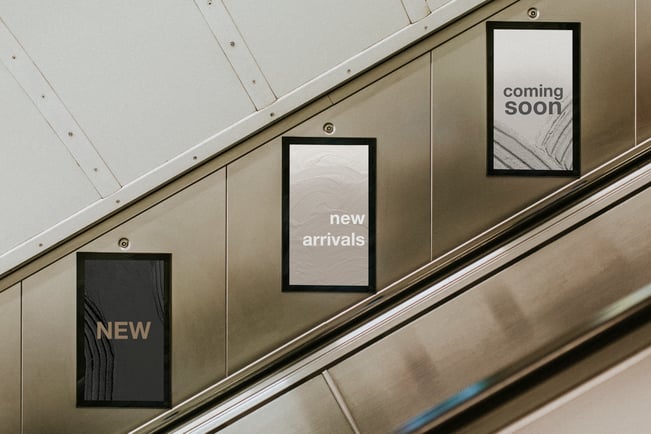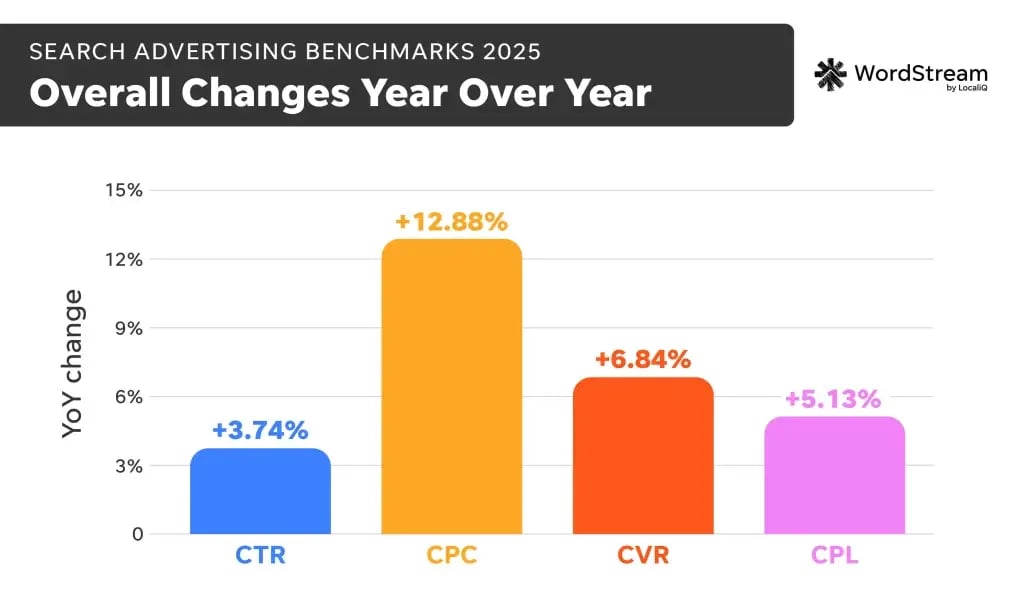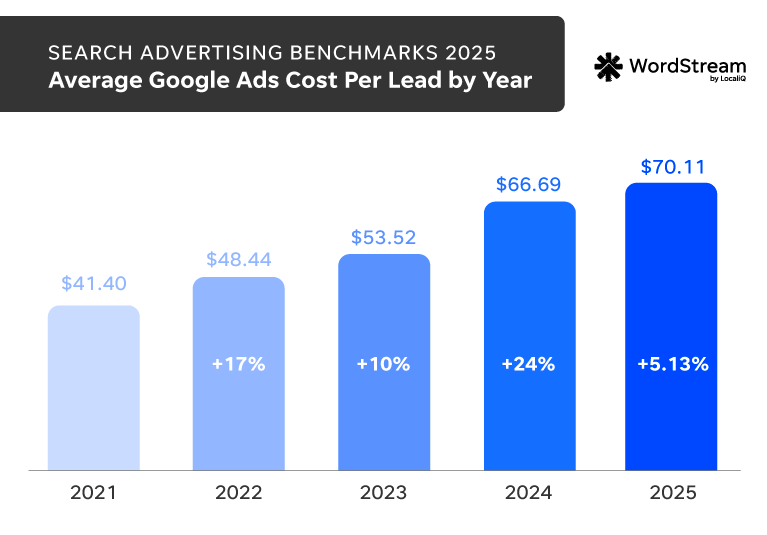
Your media budget is under unprecedented pressure. Average Google Ads cost-per-click (CPC) climbed to $5.26 in 2025, up 12.88% year-on-year according to WordStream's 2025 Google Ads Benchmarks Report. Meanwhile, cost-per-lead (CPL) rose by 5.13% compared to 2024.
But here's the bigger challenge: it's not just getting more expensive. It's getting blander.

Source: WordStream
As platforms push for more automation and machine learning, campaigns are starting to look identical. When every advertiser lets algorithms allocate their advertising spend, distinctiveness collapses.
Last year, we called for diversification "Beyond Google" as costs and competition intensified. Just ten months later, effective media budget management requires more than channel spread, it demands deeper customer understanding, stronger first-party data, and creativity that actually delivers results.
The Advertising Cost Crisis No One Can Ignore
This isn't just inflation affecting your media budget. It's structural.

Source: Search Engine land
More advertisers, more automation, and shrinking premium inventory are driving costs relentlessly upward. Search Engine Land's CPC inflation analysis shows advertisers paying larger portions of their budget per click even as click-through and conversion rates edge up. Multiple industry sources confirm this trend with PPC Land's 2024 metrics showing 86% of industries experienced CPC increases – some sectors by over 25%.
You're paying a premium just to maintain market position. Every pound of your advertising investment simply buys less than it did twelve months ago. This creates a vicious cycle where brands must either increase spend or accept declining market visibility. Source:

Source: WordStream
How Platform Automation Is Flattening Campaign Performance
The rise of AI-driven advertising tools promises efficiency but delivers homogenization. Platforms are racing towards "full AI" dominance of campaign management, fundamentally changing how brands can differentiate themselves.

Source: EMARKETER
Google's AI-First Approach
Google have doubled down on Performance Max (PMAX) – a hands-off campaign type where you provide text, image and video assets alongside “audience signals” (demographic and interest data) rather than traditional keywords. Algorithms then determine sees your ads and in which format.
Their latest AI Max for Search promises to “supercharge” performance with one-click optimisation of assets and targeting. While convenient, this approach means your campaigns increasingly mirror those of your competitors. Source:
Meta's Advantage+ Automation
Meta's Advantage+ suite, powered by AI, continues absorbing more optimisation decisions—from ad placement to creative mix. The platform is phasing out manual targeting from some campaigns entirely, with plans for fully automated campaigns by 2026.
However, automation often misses crucial context. On one client campaign, Meta's AI changed the order of carousel slides to "improve performance"—but our slides told a specific story that required a particular sequence. The AI clearly didn't understand the narrative flow, forcing us to pause all Advantage+ settings to prevent further unwanted changes.
The Core Problem with Full Automation
When Meta's engineering team promises their Andromeda automation system will handle end-to-end campaign management by inputting just your URL and budget, it sounds like efficient marketing. In practice, it means thousands of brands draw from identical datasets, optimisation targets, and creative templates.
Automation optimises for averages—it rarely uncovers your unique competitive advantages.
Regulatory Pressure Compounds the Challenge
Alongside the AI push comes tighter restrictions affecting campaign targeting and optimisation.
From January 2025, many health and wellness brands lost access to bottom-of-funnel conversion events (tracking when users complete purchases or fill in forms), forcing them towards softer goals like "Landing Page Views". This fundamentally changed how their advertising performs, as optimising towards users with higher purchase intent is no longer possible within this industry.
Regulators are circling too. Meta's "pay-or-consent" model, which allows users to either consent to data collection or pay for an ad-free experience, faces potential hefty DMA (Digital Markets Act) fines. As regulation constrains what platforms can track or charge for, brands relying on platform data for decisions will feel the pinch first.
How Brands Can Differentiate?
When automation levels the playing field, these approaches separate winners from losers:
1. Leverage First-Party Data
and privacy frameworks tightening, your own customer data becomes crucial for efficient targeting. Clean, connected, consented data (information customers have explicitly agreed to share) lets you brief platforms with high-quality targeting that maximises impact.
IAB's 2024 digital advertising revenue report confirms this trend - digital ad spend is growing at 15% annually while internet user growth remains flat at 1.8%, creating fundamental supply-demand imbalances that reward sophisticated targeting.
2. Optimise Your Tracking Setup
Don’t let advertising platforms optimise for "clicks" regardless of business impact. Running lead focused campaigns without accurately tracking lead generation will hinder both automated bidding strategies and your ability to assess performance. How can you optimise what you can’t measure?
3. Understand Your Audience Deeply
Take time to truly consider who your audience is, their daily pain points, and how to position your offering as the solution. Research competitors' ads critically—what would your reaction be as a potential customer? What would you change?
Consider the types of creatives and messaging most likely to resonate, then take calculated risks with new assets that stand out from industry norms.

Uber Eats created a campaign to ‘free grandmas’ in Mexico
4. Craft Scroll-Stopping Creatives
Platform AI can remix assets, but it can't originate your brand story. Distinctive creative, mapped to actual customer journey stages, remains the human edge that transforms advertising spend into meaningful returns.
In a sea of AI-crafted ad copy and uninspired imagery, creativity and emotional resonance will truly separate your ads from those mindlessly scrolled past. Whether through relatable content that speaks emotionally to your audience or references to current cultural moments, differentiation and emotion are your strongest tools.

This brand decided to use a global meme as inspiration for their ads – if you know, you know…
5. Refresh and Test Continuously
The longer your ads run, the sooner you reach saturation – when most people who will see your ad have already have. Regular review helps identify underperformers wasting budget and replace them with fresh approaches using new creatives, different formats, or updated offerings.
Constant A/B testing helps avoid ad fatigue. Perhaps your ads didn’t appeal to someone initially, but your new creatives and messaging might be more enticing now.
The Economic Reality: Platform Interests vs. Your Success
The numbers reveal an uncomfortable truth about platform priorities.
Annual advertising revenue of Meta Platforms worldwide from 2009 to 2024 (in million U.S. dollars)

Source: Statista
Statista's global advertising revenue data shows Meta generated $165+ billion from advertising in 2023 – 98% of their total revenue. With that level of dependency, there's an unavoidable conflict of interest when platforms control your campaign decisions through automation.
When Meta's algorithms manage your advertising allocation, they're optimised to maximise Meta's revenue, not your business profitability. Every "automated optimisation" is designed to increase your spending, not optimise it.
This is why independent, client-focused campaign management becomes essential—someone needs to advocate for your budget efficiency, not Google's or Meta's revenue growth.
Breaking Free From The Automation Trap
At Innovation Visual, we don’t just "spend your media budget." We help you maximise spend efficiency despite rising costs and opaque algorithms by working on the following:
- Audit and enrich first-party data to ensure CRM, web analytics, and offline conversion data are accurate, connected, and activation-ready
- Build journey-aware content ecosystems from top-funnel education to bottom-funnel action that protect against diminishing returns
- Implement continuous optimisation through incremental testing, clean data validation, and quick pivots when needed
The brands that thrive in this environment won't be those that spend the most—they'll be those that combine human insight with intelligent automation, creating campaigns that both perform and stand out.
Your advertising investment doesn't have to spiral out of control. With the right approach, every pound can deliver maximum impact while maintaining the distinctiveness that drives real business results.
Let's Talk Media Budget Efficiency, Not Just Spend
Rising costs and homogenised automation are eroding margins across industries. Your marketing investment faces unprecedented pressure, but your ads don't have to blend into the background.
Innovation Visual can help you turn first-party data, genuine audience insight, and meaningful creative into campaigns that perform and stand out from the crowd.

.png?width=250&height=141&name=image-gen%20(1).png)








